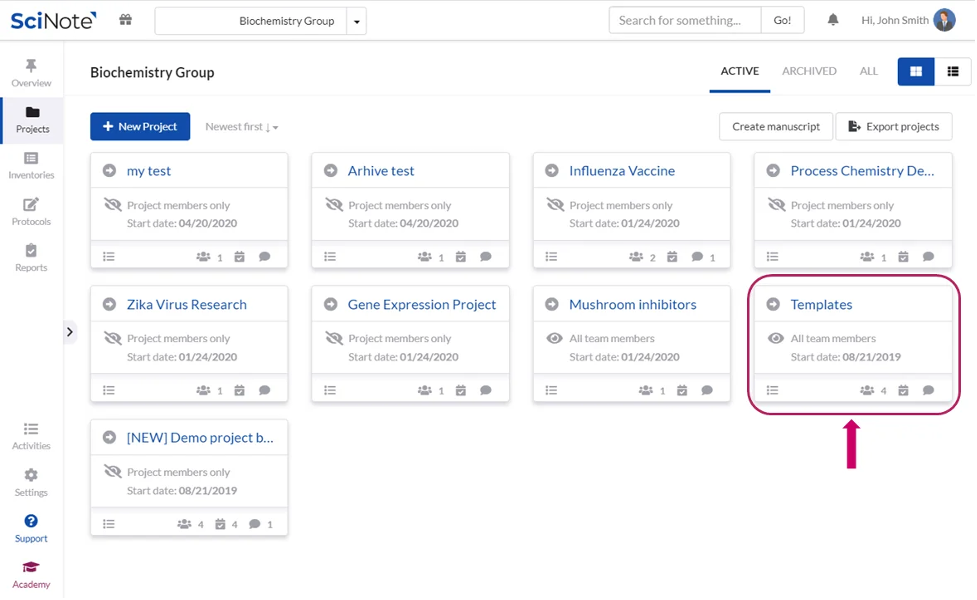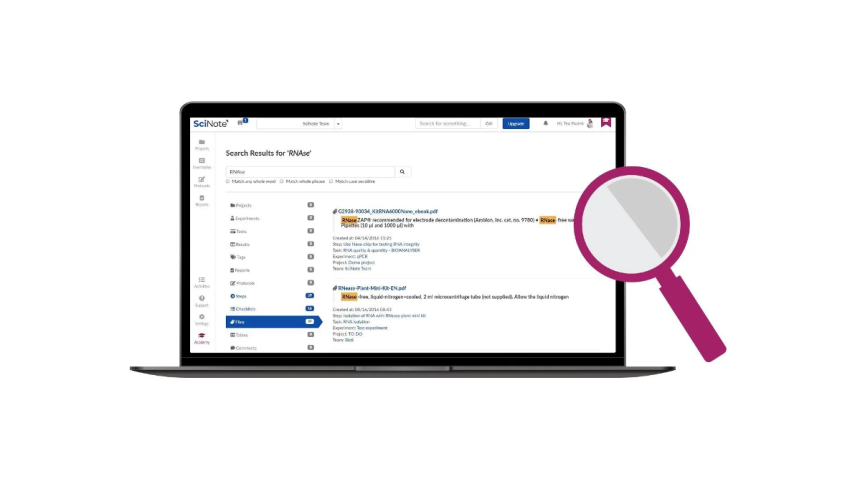Using top-rated SciNote ELN software allows researchers to spend more time on innovation and less on routine work. This is made possible through a synchronized workflow enabled by an integrated system.
Among other functionalities, an ELN supports a projects/experiments/tasks structure that emulates how research happens and allows flexibility to be customized to your lab’s preferred setup. It also enables efficient data recording and digital document compliance with GxP and 21 CFR Part 11 standards.
Streamlined Experimentation
Unlike the messy, handwritten lab notebooks that were once used in research labs, ELNs are highly efficient tools that join data organization and project management with a flexible structure. They allow researchers to store all their protocols and related data in one place, which makes it easier for authorized lab members to access the information they need. It also reduces the time spent asking for instructions as everything is well-documented and organized.
Lab managers can easily track inventory, communicate with team members through comments and tags, create templates, and automatically generate project reports to save on report writing and administrative tasks. This helps reduce overall lab workload by saving on average 9 hours/week for scientists.
In addition, it can help speed up electronic regulatory submission and review, maintain quality control, manage the workflow for GxP compliance, and meet 21 CFR part 11 standards with digital document signatures and audit trails. Moreover, it allows scientists to spend more time on innovation by reducing repetitive tasks like sample tracking and report generation.
Data Accessibility
Modern labs generate massive amounts of information, and keeping this data organized can be difficult. An ELN provides a central location where scientists can keep track of all their research. This allows for easy access when it is needed, and makes it much easier to organize all your experimental results and protocols in one place.
Another benefit of an ELN is the ability to share your research data with collaborators. This can be done in a secure way, so you can choose who sees what information. This means that you can easily share important results with other researchers without having to email them or make copies of your notebook pages.
Adding an ELN to your lab gives you more time to spend on priority tasks like writing papers or grant applications. On average, a designated person saves measurable hours each day, and this adds up over the long term.

Enhanced Collaboration
Choosing an electronic laboratory notebook can dramatically improve your lab’s productivity, but you must consider the needs of your team before making any purchasing decisions. To maximize the benefits of an ELN, it’s important for lab professionals to communicate regularly. This could be done through digital communication platforms or even regular in-person meetings.
It is also critical for laboratories to ensure all members understand how to use an ELN, which may require training and/or documentation of specific functionalities. Ultimately, the time invested in the implementation stage will be worth it in the long run.
Many labs have adopted SciNote to improve inventory management and data traceability. The team was able to easily migrate inventories into the system, and they can now access their protocols with a click. Furthermore, they can create an automated workflow that automatically generates project reports, which eliminates a lot of time-consuming manual work.
Task Automation
In a time where scientific research is becoming increasingly complex, automation can help streamline routine tasks. This allows lab staff to spend more time on the work they’re trained to do, rather than performing manual processes that are less important or difficult. Automating these tasks, also removes the chance for human error, making it easier to achieve consistent quality and precision.
ELNs have proven to be valuable for many research teams, and it’s not uncommon to see labs increase their productivity by as much as 9 hours per week after adopting a robust solution such as SciNote – Electronic Lab Notebook. This time savings is primarily due to the reduction in paperwork and meetings, as well as increased efficiency in data analysis.
Another significant factor is that ELNs make it easy to organize inventory, post comments tag team members, delegate tasks with specific due dates, and more. This makes it easy to meet governmental digital document standards and 21 CFR part 11 compliance.
Data Analysis Integration
A great feature that most ELNs provide is the ability to use visual tools that can make it easier to analyze and understand data. This helps researchers spend less time searching and more time getting to the bottom of the story behind the data.
It also ensures that the data retrieved is relevant to their experiment. This helps the lab become a dynamic and responsive environment, making it a more productive place to work.
In the modern laboratory, information is being produced at a rapid rate. This information needs to be organized methodically in order to be useful. An ELN like SciNote can help with this by providing features that allow for the organization of data in a way that is intuitive to scientists. This includes a projects/experiments/tasks structure that mimics how research happens, a flexible set-up that can be tailored to your lab, and the ability to connect data with each other through templates.
Remote Access
Using an ELN increases lab productivity by making it easier to manage all data types and collaborate with team members remotely. This saves time for reporting, scheduling, and planning as well as answering emails. In fact, researchers on average save 9 hours per week after implementing an ELN.
A good ELN should have a flexible structure that emulates the way research happens in the lab. This helps in easy adoption by keeping the structure familiar. SciNote, for example, has features that help labs define their process by connecting a set of cards (experiments, pictures, protocols) into a flow that is not linear and assigns due dates to individual parts.
It also enables them to achieve governmental digital document standards and maintain a high level of transparency within the research community. Furthermore, it enables them to keep track of all the necessary equipment and materials.
End Note
The capacity to effectively handle data, expedite procedures, and promote cooperation is crucial in today’s fast-paced scientific environment. In addition to these benefits, SciNote ELN enables researchers to devote more time and effort to innovation, thereby expanding the boundaries of scientific understanding. The use of SciNote ELN might fundamentally alter your laboratory’s quest for productivity and quality in research.
Lynn Martelli is an editor at Readability. She received her MFA in Creative Writing from Antioch University and has worked as an editor for over 10 years. Lynn has edited a wide variety of books, including fiction, non-fiction, memoirs, and more. In her free time, Lynn enjoys reading, writing, and spending time with her family and friends.















